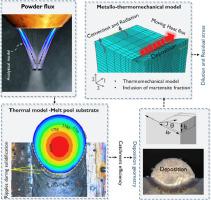International Journal of Mechanical Sciences ( IF 7.3 ) Pub Date : 2021-09-06 , DOI: 10.1016/j.ijmecsci.2021.106790 Chaitanya Vundru 1, 2 , Ramesh Singh 1 , Wenyi Yan 2 , Shyamprasad Karagadde 1

|
Laser directed energy deposition (DED) is an innovative additive manufacturing technology with tremendous potential for remanufacturing and repairing critical components. For sustainable repair, it is necessary to control the deposition geometry and integrity in terms of residual stresses and dilution. Obtuse contact angles and inadequate dilution can lead to inter-track porosity and cracks at the edge of the deposition-substrate interface. In addition, the fatigue life of the restored part is compromised if tensile residual stresses are induced in the deposited layer. A comprehensive modeling approach presented in this paper integrates analytical formulations for the laser-powder interaction and the powder entrapment in the melt pool, with the finite element models for determining the melt pool characteristics and the residual stresses. This model captures the physics of the key phenomena in DED, namely, power attenuation due to laser-particle interaction, melt-pool formation, powder catchment in the melt pool, and the residual stress evolution due to differential thermal contraction and metallurgical transformations. The model predictions have been experimentally validated for residual stresses, dilutions, catchment efficiencies, powder flux, and deposition geometries for crucible particle metallurgy (CPM 9V) steel powder on H13 tool steel. CPM 9V is a preferred material for repairing H-13 molds. Extensive simulations have been carried out using the comprehensive analytical-computational model to develop data-driven expressions for deposition geometry, normalized dilution, and residual stress as a function of process parameters (laser power, scan speed, and powder feed rate). For identifying the preferred deposition regime, these relations are employed to bifurcate the entire operating space into obtuse and acute contact angle, insufficient and sufficient dilution, tensile and compressive residual stress. Higher values yield depositions with the desired acute contact angles and higher specific energies induce favorable compressive longitudinal residual stress in the depositions.
中文翻译:

激光定向能量沉积的综合分析计算模型,用于预测沉积几何形状和完整性以实现可持续修复
激光定向能量沉积 (DED) 是一种创新的增材制造技术,在再制造和修复关键部件方面具有巨大潜力。对于可持续修复,有必要在残余应力和稀释方面控制沉积几何形状和完整性。钝角接触角和稀释不充分会导致沉积-基材界面边缘的轨道间孔隙率和裂纹。此外,如果在沉积层中产生拉伸残余应力,则恢复部件的疲劳寿命会受到影响。本文提出的综合建模方法将激光-粉末相互作用和熔池中粉末截留的分析公式与用于确定熔池特性和残余应力的有限元模型相结合。该模型捕捉了 DED 中关键现象的物理特性,即由于激光-粒子相互作用、熔池形成、熔池中的粉末集水以及因差热收缩和冶金转变而导致的残余应力演变的功率衰减。对于 H13 工具钢上的坩埚颗粒冶金 (CPM 9V) 钢粉的残余应力、稀释度、集水效率、粉末通量和沉积几何形状,模型预测已经过实验验证。CPM 9V 是修复 H-13 模具的首选材料。已经使用综合分析计算模型进行了广泛的模拟,以开发沉积几何、归一化稀释和残余应力作为工艺参数(激光功率、扫描速度和送粉速度)函数的数据驱动表达式。为了确定优选的沉积方式,这些关系被用来将整个操作空间分为钝角和锐角接触角、不充分和充分稀释、拉伸和压缩残余应力。更高 值产生具有所需锐角接触角和更高比能的沉积物 在沉积物中引起有利的压缩纵向残余应力。


























 京公网安备 11010802027423号
京公网安备 11010802027423号